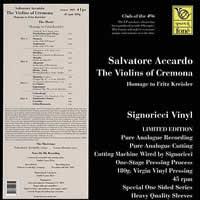Purist All-Analog Recording, 45rpm One Step, Single-Sided Pressing!
Foné records’ Giulio Cesare Ricci is easily one of the most charming, entertaining and eccentric people I have ever encountered in an industry packed with such people. I spent some quality time with him and his lovely wife Paola Maria, who works in the fashion industry in Milan, during last fall’s Top Audio show there.
Mr. Ricci’s label issues purist recordings on CD, SACD and LP. The LPs are also “purist” in that they are one sided, “single step” productions, meaning that the cut lacquer is plated and that negative (the part with the ridges instead of grooves) is then used to press the LPs.
Standard pressings are made by using that negative, called the “father,” to generate another grooved positive called the “mother,” from which “stampers” are then generated that go into the presses to make records. The reason for the extra step is that many “mothers” can be generated from a single “father” before it wears out, so that many more records can be pressed before another lacquer has to be cut from the master tape.
Using the original “father” results in a purer product, but is impractical in commercial record production, since once it’s worn out it after a single pressing run, it must be discarded.
This is not an issue for Mr. Ricci’s releases, as he’s decided to produce only 496 copies of each. He’s also a winemaker, and his last vintage, a Merlot if memory serves, was also issued in a limited, 496 bottle edition. Why 496? He likes the number.
Foné has issued both 2 LP, double sided 33 1/3rpm and 4 LP, single sided, 45rpm releases, all recorded in the analog domain, some on a Nagra 4S two-track recorder, using Neumann U47, U48 and M49 tube microphones, Ricci designed and built cabling, and microphone and line preamplifiers. Mr. Ricci also wired and modified his cutting lathe, which he purchased from David Manley some years ago.
The recording I chose to highlight, an homage to Fritz Kreisler, was recorded back in 1993 in Cremona’s Palazzo Cavalcabó, with the distinguished violinist Salvatore Accardo backed by Laura Manzini on piano. Many of these short, tuneful, florid pieces will be familiar to even those with a passing knowledge of classical music, as they often find their way into television commercials advertising CD collections of classical music’s greatest “tunes,” and are used whenever background music is needed to connote drawing room sophistication (“Liebesfreud” for instance, or Chopin’s “Mazurka”).
However, while I can recommend this expensive 4 disc set to those who know and love that music, a more recent recording, from November, 2005 and issued last year on two 45rpm single sided, “one step” 180g LPs pressed at Pallas demonstrate that Mr. Ricci’s recording techniques and abilities have improved greatly over time.
The set (foné 011) of Paganini pieces performed again by Mr. Accardo (playing a Stradavari Vesuvio 1727) back by the Orchestra Da Camera Italiana and recorded live to two-track Ampex ATR 100 on half-inch tape at 30IPS in Cremona’s Teatro Amilcare Ponchielli before a remarkably sniffle and cough-free audience, features sublime, weep-inducing sonics of such harmonic and textural purity, each bow sweep will induce gargantuan goose bumps.
Though the sides are short (twelve and fourteen minutes), the sonic and musical pleasures are intense as the orchestra and particularly Mr. Accardo’s violin, is presented with stunning transparency and three-dimensionality. These pieces, especially “La Campanella,” will also be familiar to many listeners who know little classical music.
It’s also easy to recommend a 2000 recording of Vivaldi’s “The Four Seasons” using a Studer C-37 (foné 007). As for the lacquer Mr. Ricci handed me before I left Milan last September, don’t ask!
I am not sure which of these titles are still available, given the small press run, but if you like well-recorded violin, you won’t be disappointed with any of these limited edition titles (www.fone.it). Check your local vinyl vendor for availability.
- Log in or register to post comments


